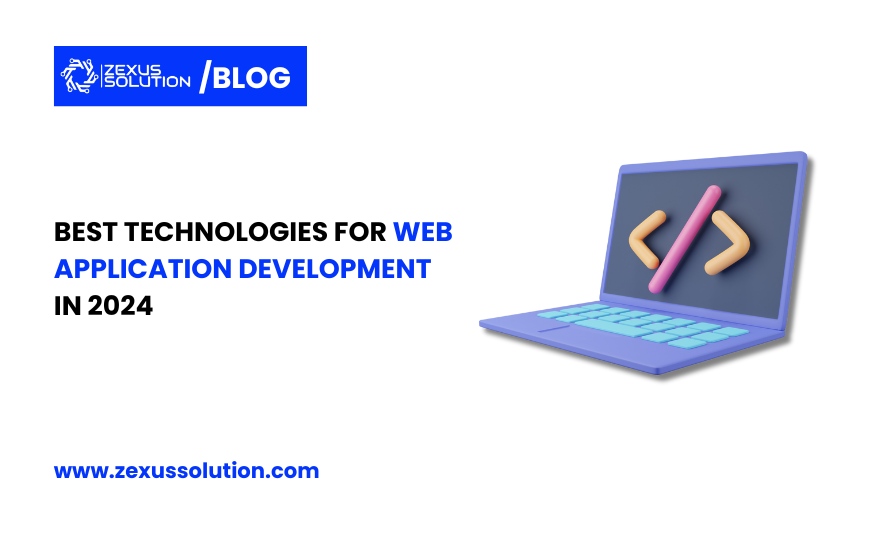Table of Contents
Looking forward to 2024, the advancement in the web application development process is dynamic. New and existing technologies appear, providing developers with the tools and frameworks to create high-performance, safe, and easily maintainable web applications. It brings the need to select the best technologies for web applications.
This article will discuss the suitable technologies for web app development in 2024 based on front-end and back-end technologies, security measures, performance boosters, and maintenance services.
Front-End Technologies

React
React, by Facebook, is one of the most widely used front-end frameworks because of its component-based design, which allows for the creation of highly complex and engaging user interfaces. Virtual DOM in React improves the web app’s performance by reducing costly operations with DOM.
React’s robust ecosystem, including libraries like Redux for state management and Next.js for server-side rendering, makes it a versatile choice for web application development. In 2024, React’s popularity continues to grow, supported by a vast community and extensive documentation.
Angular
Another popular front-end framework is Angular, created by Google and recognized for being more extensive than others. It involves a complete MVC (Model-View-Controller) framework, which is useful in the creation of applications that can be extended easily and with minimal effort.
Angular is TypeScript based on strong typing, natively supports unit testing, and has a powerful CLI (Command Line Interface) which makes it the preferred choice for developers who want to develop large-scale enterprise applications. It has two-way data binding and dependency injection that makes the development processes efficient and fast.
Vue.js
Vue. js has received a lot of popularity in the last few years and remains a favored option and one of the best technologies for web applications in 2024. It is easy to learn, has a relatively small steep learning curve, and has extensive documentation for its framework.
Vue. js, along with its extensions such as Vue Router for routing and Vuex for managing the state, provide a great opportunity to build complex and unique web applications. Template syntax and the reactivity system are the factors that make it fast and very responsive.
Back-End Technologies

Node.js
Node. js continues to stay popular in back-end development since it does not block the execution of other code. It enables developers to create network applications that can support a large number of users on both the server and the client fronts, using JavaScript.
Node. js’s package manager, npm, has an extensive archive of modules and libraries that can be easily integrated into a range of features. Some of the technologies it supports are microservices architecture, real-time applications like chat applications, and online gaming, making it a versatile back-end technology.
Django
Django is a Python-based Web framework with a ‘batteries included’ concept recognizable in the Python community. It comes with a rich suite of tools and functionalities that help in the creation of web applications that are secure and easy to maintain.
Django provides you an Object-Relational Mapping (ORM) to work with databases and the application has in-built security measures for protection like SQL injection and cross-site scripting (XSS) protection. This year, 2024, Django remains a go-to framework for developers, especially those who need to build secure and efficient applications.
Ruby on Rails
Rails, commonly called Ruby on Rails, is a web framework for scripting server-side web applications in Ruby. It stresses CoC (convention over configuration) and DRY (Don’t Repeat Yourself) which helps in the reduction of development cycles.
It is a hugely popular framework many developers choose Rails because of its simplicity, vast collections of libraries (gems), and exceptional community support to implement web applications rapidly. Focusing on simple and conventional code allows developers to prevent many mistakes and have clear and easy-to-read code.
Databases

PostgreSQL
PostgreSQL is an open-source RDBMS that is famous for its stability, ability to scale, and SQL conformity. It is very suitable for web application development due to its support for complex data types, indexing methods, and full-text search.
In 2024, PostgreSQL remained popular due to its capacity to perform well in OLTP (Online Transaction Processing) and OLAP (Online Analytical Processing) applications. Some of the benefits of using Django are; that it has robust security measures such as data encryption and access rights that help protect your web application.
MongoDB
MongoDB is a NoSQL database that is very flexible and can scale up easily. Due to the document orientation, NoSQL can store semi-structured data, which is beneficial for applications with developing data models.
MongoDB’s use of horizontal scaling and distributed systems makes it ideal for use in large-scale web applications. Indexing features, a robust query language, and in-built replication and sharding play a vital role in improved web app performance.
Redis
Redis is an in-memory data structure store that is commonly used as a cache or message broker. This characteristic makes it an essential element in web application infrastructure as it can support high throughput and low latency operations.
Thus, Redis is still among the best technologies for web applications, especially where real-time data processing requirement exists and for the data, which are frequently accessed and enhancing its performance. The flexibility it offers towards different data types like string, hash, lists, and sets helps in the management of all sorts of data.
DevOps and CI/CD Tools

Docker
Docker changed the way that applications can be deployed by allowing containers. Application containers provide a structure for an application and its dependencies while providing a guarantee that the application will behave in the same way regardless of the environment in which it is hosted.
In 2024, Docker still plays a critical role in DevOps, which enables developers to create, package, and deploy applications quickly and effectively. Its integration with orchestration tools like Kubernetes helps in the large-scale management of containerized applications thereby improving the performance and reliability of web applications.
Jenkins
Jenkins, as an open-source automation server, is utilized for continuous integration and continuous deployment (CI/CD). It deals with application development, testing, and deployment by making them faster as well as more reliable.
Due to Jenkins’ vast plugin library and strong pipeline features, it remains a flexible option for adopting CI/CD practices. Looking at the year 2024, Jenkins remains one of the best technologies for web application development as it helps to sustain high development velocity and guarantee the quality and security of web applications.
GitHub Actions
GitHub Actions is a CI/CD tool integrated with the GitHub platform that enables the developers to orchestrate workflows from the repository. This allows it to be easily integrated with GitHub and support for custom scripts and actions make it a great tool for DevOps.
GitHub Actions become relatively popular in 2024 because of their simplicity, versatility, and availability of various community-created actions. It assists in decreasing complexity in the development processes, as well as in enhancing communication between the members and the effectiveness of the web application development.
Security Technologies
OAuth 2.0 and OpenID Connect
OAuth 2. 0 and OpenID Connect are widely used to manage authorization and authentication, respectively. They allow for safe access by giving out tokens that stand for user identity as well as rights of access.
These protocols are essential for protecting your web app, especially if your app relies on third-party integration and SSO. Implementing OAuth 2. 0 and OpenID Connect makes sure that the user data obtained is secure and granted access is justified.
Web Application Firewalls (WAF)
A Web Application Firewall (WAF) is a security technology that works by filtering HTTP requests to prevent potentially damaging traffic. They are essential in preventing generic risks like SQL injection, cross-site scripting (XSS), and denial of service (DoS).
In 2024, WAFs continue to be an essential part of the web application security checklist of requirements and solutions. Cloudflare, AWS WAF, and Azure WAF are some of the tools that provide protection and threat intelligence and allow for the setting of various rules to protect web applications.
Multi-Factor Authentication (MFA)
Multi-factor authentication (MFA) is an additional layer of security where the user has to provide two or more factors of identification to get access to the desired account. This minimizes the possibility of a break-in through passwords as they can be easily guessed or hacked.
In 2024, MFA continues to be a best practice for protecting your web app. The use of MFA with the help of applications such as Google Authenticator, Authy, or hardware tokens increases the level of protection and minimizes the risk of account violation.
Performance Optimization Tools

Google Lighthouse
Google Lighthouse is an open-source tool used to check the performance of web applications as well as their accessibility, SEO compatibility, and general compliance with the best practices. It produces reports and analyses of the performance that can be enhanced within the organization.
Lighthouse is still useful for developers who want to enhance the quality of their web developments. The ability to integrate it with Chrome DevTools and support for automated testing makes the performance audits easy to integrate with the development cycle.
New Relic
New Relic is a web-based application performance monitoring tool that offers real-time performance monitoring of applications. It aids in finding out where the delays are, how the resources are being consumed, and where the users are engaging with the applications.
New Relic is the solution that is most commonly used for performance monitoring. The analytics, along with the customizable dashboard, and compatibility with the development and operations tools support efficient execution and problem-solving.
WebPageTest
WebPageTest is an open-source tool that measures the performance of web applications from multiple locations and browsers. It provides detailed metrics, including load time, rendering speed, and resource usage, helping developers identify areas for improvement.
In 2024, WebPageTest remains an essential tool for performance optimization. Its detailed waterfall charts, filmstrip views, and performance recommendations help developers make informed decisions to enhance web app performance.
How To Select the Best Technology for Web Application Development
- The first step is to analyze your project requirements, what features you want, and the performance demands for your web app.
- When working on a project and you need to choose the best technology for a web application, consider your team’s expertise and their experience with different technologies.
- Then estimate the time and your budget regarding the technology you are using.
- Now comes the maintenance part so select the tech stack that has a rich community and support for future endeavors. You will be able to avail of web app maintenance services if needed.
Conclusion
In 2024 and beyond, the best technologies for web applications are the front-end and back-end frameworks, databases, DevOps tools, security measures, and performance optimization tools. With the help of these technologies, developers will be able to create the necessary web applications for today’s users that are fast, secure, and easy to maintain.
It is important to be up-to-date with the current trends and approaches that are viable in the rapidly growing domain of web apps. Prioritize these technologies to outcompete rivals and offer excellent web experiences.



Add a Comment